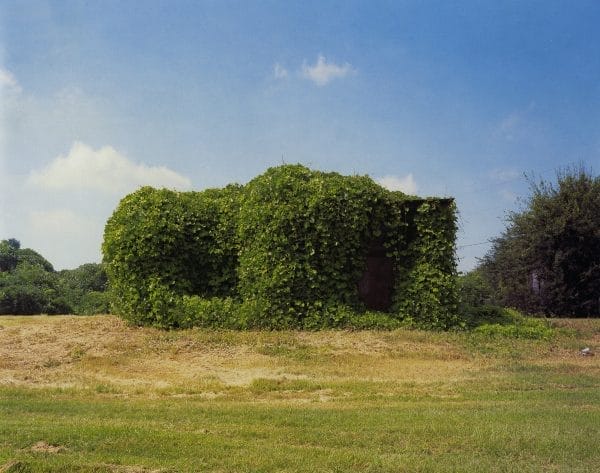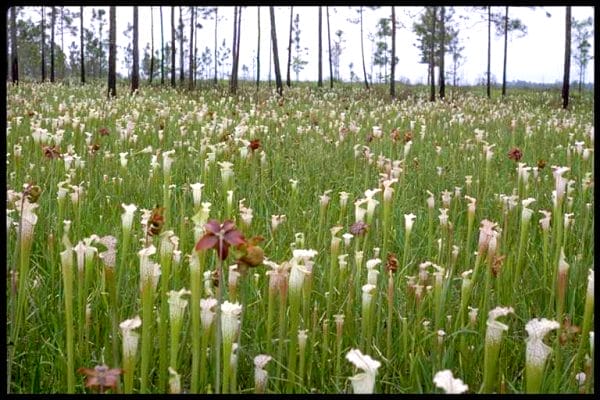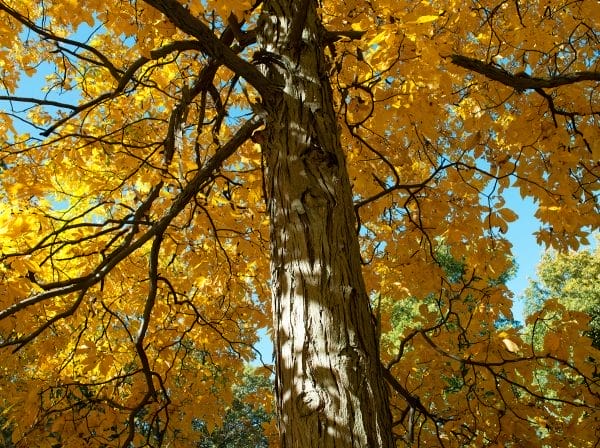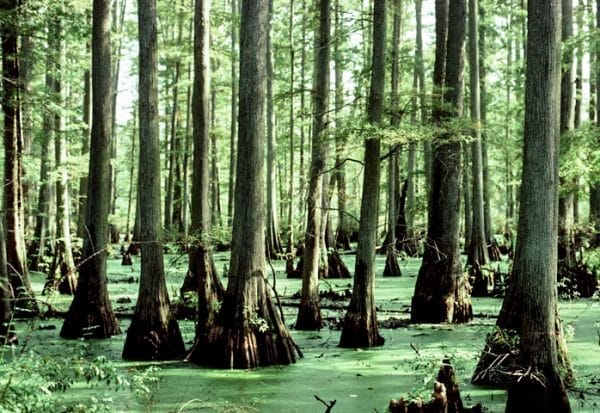Plant Communities of Alabama
Alabama is home to a remarkable diversity of natural environments, extending from the sun-drenched shores of the Gulf Coast to the forested coves and mountains of the northern counties. In addition to its location at the convergence of five regional physiographic sections, the state encompasses 52,423 square miles, a size that accommodates a vast richness of flora and fauna and a mosaic of unique habitat types. With more than 200 plant associations, Alabama stands near the top in terms of plant diversity among all the states, harboring a suite of natural communities and species not found elsewhere on the planet.
 Umbrella-Tree
Alabama is divided by geologists into a series of five physiographic sections, and each harbors a distinctive assemblage of plants and natural communities specifically adapted to the prevailing environmental conditions. Natural communities and their respective plant species do not occur where they do by chance, but because each environment has specific and unique characteristics. A nearby area that appears similar yet does not support a particular community type often differs, upon closer examination, in subtle but important ways: soil depth, texture, or nutrient status; history of disturbance; slope direction; intensity of sunlight; or availability of moisture. The influence of differing environmental conditions on plant communities is clearly visible in the various sections of Alabama.
Umbrella-Tree
Alabama is divided by geologists into a series of five physiographic sections, and each harbors a distinctive assemblage of plants and natural communities specifically adapted to the prevailing environmental conditions. Natural communities and their respective plant species do not occur where they do by chance, but because each environment has specific and unique characteristics. A nearby area that appears similar yet does not support a particular community type often differs, upon closer examination, in subtle but important ways: soil depth, texture, or nutrient status; history of disturbance; slope direction; intensity of sunlight; or availability of moisture. The influence of differing environmental conditions on plant communities is clearly visible in the various sections of Alabama.
The East Gulf Coastal Plain is the largest section of the state, roughly spanning the southern third of Alabama and arcing northwest to gradually parallel the Mississippi state line for a significant distance. The Coastal Plain, with its abundance of porous sandy soils and gentle topography, furnishes ideal conditions for pine-dominated habitats. In the Piedmont and Tennessee Valley and Ridge sections to the north, soils have a higher clay content, and thus the pine-dominated communities, although apparent in places, occur less frequently. Those that do exist are more commonly mixed with various hardwoods—a signature of the greater nutrient and moisture-retention capacities of the clayey soils. Hardwoods are most dominant, however, in the Cumberland Plateau and the Highland Rim sections, which cover the northernmost section of the state. Except for the highest elevations, the region is underlain by thick deposits of limestone, resulting in a rich diversity of communities not present elsewhere in Alabama.
 Kudzu Devouring Building, near Greensboro, Alabama
Alabama’s landscape has changed dramatically over the vast expanse of geologic time, and the vegetation has reflected these changes. Fluctuations in sea level, periods of mountain building, and the movement of continents all have had a significant effect on the state’s topography. In recent times, however, human-derived disturbances have so greatly altered Alabama’s natural communities that the face of the state’s landscape has been forever changed. Urbanization and agricultural productivity perhaps rest in most people’s minds as the driving force behind habitat loss and degradation. However, many of Alabama’s most beautiful wildlands are also silently under siege by aggressive biological invaders. Introduced weeds, also known as exotic or alien plant pests, have invaded thousands of acres throughout Alabama, threatening not just natural habitats, but agricultural lands as well. Chinese privet, cogon grass, kudzu, and Japanese honeysuckle are among several species of introduced plants that jeopardize the long-term integrity of the state’s natural communities. Hardly a plant community or habitat in Alabama remains unaffected by such introduced plant species.
Kudzu Devouring Building, near Greensboro, Alabama
Alabama’s landscape has changed dramatically over the vast expanse of geologic time, and the vegetation has reflected these changes. Fluctuations in sea level, periods of mountain building, and the movement of continents all have had a significant effect on the state’s topography. In recent times, however, human-derived disturbances have so greatly altered Alabama’s natural communities that the face of the state’s landscape has been forever changed. Urbanization and agricultural productivity perhaps rest in most people’s minds as the driving force behind habitat loss and degradation. However, many of Alabama’s most beautiful wildlands are also silently under siege by aggressive biological invaders. Introduced weeds, also known as exotic or alien plant pests, have invaded thousands of acres throughout Alabama, threatening not just natural habitats, but agricultural lands as well. Chinese privet, cogon grass, kudzu, and Japanese honeysuckle are among several species of introduced plants that jeopardize the long-term integrity of the state’s natural communities. Hardly a plant community or habitat in Alabama remains unaffected by such introduced plant species.
Community Types
The natural communities of Alabama can be divided into major types that relate directly to the state’s five physiographic sections, which encompass smaller unique habitats that are common or special to each section. Because no definitive source is available on the plant communities of Alabama, the following guide will furnish a general overview of each section and its representative habitat types.
East Gulf Coastal Plain Section
 White-topped Pitcher Plants
Well into the colonial era, the East Gulf Coastal Plain section was covered in a vast, rolling landscape of open pine woodland spanning the horizon as far as the eye could see. The region displayed a tapestry of widely spaced longleaf and slash pine accented by an herb-dominated understory rich in grasses and wildflowers. While vestiges of the original landscape still remain, the extensive longleaf ecosystem—once covering several million acres across the southern part of the state—has been reduced to less than 3 percent, a mere remnant of its former glory. In spite of human intervention, pristine examples can still be found and contain the greatest floral diversity of any comparably sized area in North America. Orchids, lilies, grasses, beakrushes, and sunflowers are some of the most frequently encountered, having adapted to the naturally occurring fires that frequently swept across the landscape. But among the hundreds of plant species indigenous to the longleaf system, it is the unique ability of pitcher plants, butterworts, sundews, and bladderworts to entrap and digest insects as a source of nourishment that has undoubtedly aroused the greatest curiosity. This complex of carnivorous flora attains its greatest development in pitcher plant bogs, a community type maintained on gentle slopes by rainwater percolating downward through a porous soil mixture underlain by an impervious layer of clay. Once reaching this clay zone, the downward movement of water is then propelled along a sloping gradient eventually surfacing further downslope to create the bog community. Some of Alabama’s finest pitcher plant bogs can be found about an hour’s drive north of Mobile at Splinter Hill Bog, a joint ownership between The Nature Conservancy and the Alabama Department of Conservation and Natural Resources.
White-topped Pitcher Plants
Well into the colonial era, the East Gulf Coastal Plain section was covered in a vast, rolling landscape of open pine woodland spanning the horizon as far as the eye could see. The region displayed a tapestry of widely spaced longleaf and slash pine accented by an herb-dominated understory rich in grasses and wildflowers. While vestiges of the original landscape still remain, the extensive longleaf ecosystem—once covering several million acres across the southern part of the state—has been reduced to less than 3 percent, a mere remnant of its former glory. In spite of human intervention, pristine examples can still be found and contain the greatest floral diversity of any comparably sized area in North America. Orchids, lilies, grasses, beakrushes, and sunflowers are some of the most frequently encountered, having adapted to the naturally occurring fires that frequently swept across the landscape. But among the hundreds of plant species indigenous to the longleaf system, it is the unique ability of pitcher plants, butterworts, sundews, and bladderworts to entrap and digest insects as a source of nourishment that has undoubtedly aroused the greatest curiosity. This complex of carnivorous flora attains its greatest development in pitcher plant bogs, a community type maintained on gentle slopes by rainwater percolating downward through a porous soil mixture underlain by an impervious layer of clay. Once reaching this clay zone, the downward movement of water is then propelled along a sloping gradient eventually surfacing further downslope to create the bog community. Some of Alabama’s finest pitcher plant bogs can be found about an hour’s drive north of Mobile at Splinter Hill Bog, a joint ownership between The Nature Conservancy and the Alabama Department of Conservation and Natural Resources.
Along the southern edge of the longleaf system, where Alabama meets the Gulf of Mexico, is a mosaic of coastal dunes, shallow low-lying swales, and Gulf Coast beaches. The plant life is diverse, with more than 250 species occupying this coastal fringe, several of which are not found elsewhere in the state. A specialized beach flora, well adapted to strong ocean winds and salt spray, has developed here. Perhaps the most distinctive habitat is the coastal scrub, an assemblage of stunted and twisted sand pine, sand live oak, myrtle-leaved oak, and Florida rosemary, bearing testimony to the ecological importance and abrasive force of wind and salt water.
 Mobile-Tensaw Delta
Positioned at the confluence of the two great river systems draining much of Alabama is the Mobile-Tensaw River Delta, a vast and complex mosaic of water, marsh, and bottomland forests. These mighty rivers, the Alabama and Tombigbee, along with their tributaries, continuously alter the landscape as they deposit their mineral and organic particles before emptying into the Gulf of Mexico. The accumulation of these fine-textured deposits from the state’s interior over thousands of years has created a magnificent delta, one of the largest in North America. Bottomland and swamp forests comprised of bald cypress, water tupelo, swamp black gum, overcup oak, water oak, pumpkin ash, sweet gum, sycamore, and river birch largely symbolize the area, greeting drivers passing through on I-65.
Mobile-Tensaw Delta
Positioned at the confluence of the two great river systems draining much of Alabama is the Mobile-Tensaw River Delta, a vast and complex mosaic of water, marsh, and bottomland forests. These mighty rivers, the Alabama and Tombigbee, along with their tributaries, continuously alter the landscape as they deposit their mineral and organic particles before emptying into the Gulf of Mexico. The accumulation of these fine-textured deposits from the state’s interior over thousands of years has created a magnificent delta, one of the largest in North America. Bottomland and swamp forests comprised of bald cypress, water tupelo, swamp black gum, overcup oak, water oak, pumpkin ash, sweet gum, sycamore, and river birch largely symbolize the area, greeting drivers passing through on I-65.
Extending as a narrow band across the southern section of the Coastal Plain is the Red Hills district, a region laced by steep, narrow ravines and pine-covered ridges. Long recognized for its unusual concentration of plant life, the Red Hills bears striking similarities to the flora of the Gulf Coast further south while also being greatly influenced by Appalachian vegetation types from the north. Longleaf and shortleaf pines, along with a prominence of southern hardwoods including various white and red oaks, mockernut hickory, black gum, and sourwood, have come to characterize the driest sites. It is the ravines, however, that hold a particular fascination for all manner of biologists, from botanists to zoologists. Here, in forests comprised of beech, southern magnolia, white oak, black oak, yellow poplar, bigleaf magnolia, and spruce pine is one of the state’s rarest and most cherished wildlife species: the Red Hills salamander, a burrow-dwelling animal unique to Alabama. Too, an array of herbs such as ginseng, wild geranium, and foamflower familiar to Appalachian adventurers reach their southern range limits in the Red Hills.
 Blazing Star
Prominent among the many habitat types in the Coastal Plain are prairie landscapes, herb-dominated areas restricted primarily to the Black Belt in the western portion of the state. Grasses, most notably Indian grass (also known as “gold stem” because of its yellow stem and plume-like seedhead) and little bluestem, are found in all prairies, comprising much of the vegetation. Preferring wetter ground, often downslope of Indian grass, is big bluestem. Much rarer than Indian grass and little bluestem, it is also known as “turkey foot” because of its three-branched seedhead. Although these three grasses have come to symbolize the prairies, they are not alone. Scattered amidst the bluestem and Indian grasses stand the midgrasses: side-oats grama, hidden dropseed, slimspike three-awn, wiry witchgrass, and many others. Accenting the grasses, from the waning freezes of winter until the first hard frost, there is no time when the prairies are not accented with wildflowers of some kind. Throughout the year, a succession of coneflowers (prairie and pale), prairie clovers, rosinweeds, blazing stars, asters, and goldenrods establish displays of floral elegance, responding to the growing grasses with which they must compete. All told, the Black Belt prairies hold about 30 types of grasses and nearly 220 kinds of wildflowers, including many rare and unusual species, such as the eared false-foxglove, a species that was believed to be extinct in the state since 1940.
Blazing Star
Prominent among the many habitat types in the Coastal Plain are prairie landscapes, herb-dominated areas restricted primarily to the Black Belt in the western portion of the state. Grasses, most notably Indian grass (also known as “gold stem” because of its yellow stem and plume-like seedhead) and little bluestem, are found in all prairies, comprising much of the vegetation. Preferring wetter ground, often downslope of Indian grass, is big bluestem. Much rarer than Indian grass and little bluestem, it is also known as “turkey foot” because of its three-branched seedhead. Although these three grasses have come to symbolize the prairies, they are not alone. Scattered amidst the bluestem and Indian grasses stand the midgrasses: side-oats grama, hidden dropseed, slimspike three-awn, wiry witchgrass, and many others. Accenting the grasses, from the waning freezes of winter until the first hard frost, there is no time when the prairies are not accented with wildflowers of some kind. Throughout the year, a succession of coneflowers (prairie and pale), prairie clovers, rosinweeds, blazing stars, asters, and goldenrods establish displays of floral elegance, responding to the growing grasses with which they must compete. All told, the Black Belt prairies hold about 30 types of grasses and nearly 220 kinds of wildflowers, including many rare and unusual species, such as the eared false-foxglove, a species that was believed to be extinct in the state since 1940.
Piedmont Section
 Winged Elm
The Piedmont, or foothills, secion of Alabama takes the form of an open S-shape pattern and extends northeast from Montgomery to the Georgia border. Apart from human occupancy, the overriding influence on the natural history of the region, as with all areas in the state, is its long and complex geological past. The Piedmont today consists largely of farms, fields, and forests, with more than half of the region being made up of abandoned farmlands in various stages of reforestation by the process of plant succession. In contrast with other parts of the state, the plant communities in the Piedmont enter maturity when various oaks—most notably of the white, black, southern red, post, and scarlet varieties—assume dominance in the canopy. Although generally of lesser abundance, hickories, along with tuliptree and an occasional sweetgum, compose the canopy layer. Pines, although less common and widespread than in the Coastal Plain, are also well represented, often most abundant on upland sites.
Winged Elm
The Piedmont, or foothills, secion of Alabama takes the form of an open S-shape pattern and extends northeast from Montgomery to the Georgia border. Apart from human occupancy, the overriding influence on the natural history of the region, as with all areas in the state, is its long and complex geological past. The Piedmont today consists largely of farms, fields, and forests, with more than half of the region being made up of abandoned farmlands in various stages of reforestation by the process of plant succession. In contrast with other parts of the state, the plant communities in the Piedmont enter maturity when various oaks—most notably of the white, black, southern red, post, and scarlet varieties—assume dominance in the canopy. Although generally of lesser abundance, hickories, along with tuliptree and an occasional sweetgum, compose the canopy layer. Pines, although less common and widespread than in the Coastal Plain, are also well represented, often most abundant on upland sites.
Much more restricted in distribution and generally well hidden in the Piedmont’s oak-hickory-pine forests are some of the state’s rarest habitats. Perhaps more than any other community type in the Piedmont, the granite outcrop has come to symbolize the uniqueness and beauty of the region. An initial glance may give the viewer a false impression of a near lifeless landform. Upon closer inspection, coupled with seasonal timing, one can see an exceptional diversity of plant life. Plants such as pool sprite, granite whitlow-grass, and black-spored quillwort have developed special adaptations to endure the harsh growing conditions of granite outcrops and occur nowhere else.
Strikingly different from the gentle topography of granite outcrops but biologically as unique are laurel slicks, or heath bluffs, a community type of primarily shallow soils and steep slopes along rivers and streams. This community is so-named for the two dominant shrubs, mountain laurel and Carolina rhododendron, whose glossy leaves impart a shine to entire hillsides when viewed from afar.
Tennessee Valley and Ridge Section
 Black Gum
In this section, the Talladega Mountains extend from the vicinity of Birmingham northeast to the Georgia state line through Calhoun County and Cleburne County into Clay County and mark the southernmost extremity of the Appalachian range. This mountainous region also has the greatest elevation in the state, with several peaks exceeding 2,000 feet, including Mt. Cheaha, the highest point in Alabama at 2,407 feet. Most slopes and ridgetops are forested with an assortment of chestnut, black, and scarlet oaks; mockernut, pignut, and sand hickories; and various pines, although black gum, sourwood, and tuliptree also assume some abundance. The longleaf pine, however, commands the most attention. More commonly associated with the Coastal Plain, this tree grows near the summits of some of the region’s tallest mountains. Environmental influences, most notably altitude, fire, and the effects of a moderated climate induced by the Gulf of Mexico, have shaped and nurtured the mountain longleaf and other similar habitats to their present conditions. And as might be expected, coastal plant forms are interspersed with more northerly species, including black birch and butternut, both of which reach their southern limits here.
Black Gum
In this section, the Talladega Mountains extend from the vicinity of Birmingham northeast to the Georgia state line through Calhoun County and Cleburne County into Clay County and mark the southernmost extremity of the Appalachian range. This mountainous region also has the greatest elevation in the state, with several peaks exceeding 2,000 feet, including Mt. Cheaha, the highest point in Alabama at 2,407 feet. Most slopes and ridgetops are forested with an assortment of chestnut, black, and scarlet oaks; mockernut, pignut, and sand hickories; and various pines, although black gum, sourwood, and tuliptree also assume some abundance. The longleaf pine, however, commands the most attention. More commonly associated with the Coastal Plain, this tree grows near the summits of some of the region’s tallest mountains. Environmental influences, most notably altitude, fire, and the effects of a moderated climate induced by the Gulf of Mexico, have shaped and nurtured the mountain longleaf and other similar habitats to their present conditions. And as might be expected, coastal plant forms are interspersed with more northerly species, including black birch and butternut, both of which reach their southern limits here.
Scattered throughout the province, often well hidden from the casual observer, exists an unusual and intriguing series of naturally exposed rock outcrops known to scientists as limestone and sandstone glades. These unique communities have captured the attention of scientists and conservationists since the inception of the state’s biological studies in the early nineteenth century. Perhaps more than any other exposed substrate east of the Mississippi, the limestone “cedar glade” flora has stimulated the most serious studies of how geology influences plant communities and how plants adapt to the harsh environments of the glades. Glades vividly illustrate the impact of bedrock geology on plants. The herb-dominated vegetation is often drastically different in appearance from that of adjacent forested communities and is usually comprised of a unique and highly endemic (native to the area) flora. In fact, a Georgia botanist, along with two companions, brought to the attention of the world eight species in central Alabama previously unknown to science, heralding one of the greatest botanical discoveries made in North America during the last century. In addition to demonstrating the influences of rock type on plant life, glades also demonstrate the effects of landform on plant cover. Steepness of slope, aspect, and size also make for a marked difference in glade vegetation. Little River Canyon National Preserve in northeast Alabama and the Nature Conservancy’s Prairie Grove Glades Preserve in Lawrence County offer some of the best examples of glade environments.
Much smaller than the glade communities described above, but no less diverse, are the prairies of the Coosa Valley, intermittently scattered near the present-day cities of Centre and Gadsden. Special to these areas is an unusual assemblage of flora, including two of the rarest plants in the Southeast, the Alabama leather flower and the whorled sunflower.
Cumberland Plateau Section
 Shagbark Hickory
The Cumberland Plateau Section of Alabama and elsewhere offers an unsurpassed case history of the effects of soil type (known as edaphic effects) on vegetation and flora. Diversity of landforms, geology, and soils promotes a high degree of floristic variety that has come to distinguish this region as one of the most botanically rich in Alabama and indeed in the Southeast. Mountain summits are relatively level and are generally comprised of sandstone that supports mixed forests of oak, hickory, and sourwood as well as Virginia and shortleaf pines. With descending elevation, sandstone gradually gives way to limestone and brings about a subtle but distinctive change in vegetation. Shumard oak, chinquapin oak, sugar maple, white ash, and southern shagbark hickory, along with an abundance of understory species such as redbud, flowering dogwood, and American smoke-tree, are some of the more characteristic tree species to be found in the region. In number of species and relative abundance, ferns and woodland wildflowers are well represented. In particular, spring flowers flourish here, among them Virginia bluebells, Dutchman’s breeches, twinleaf, wood poppy, various trilliums, blue phlox, yellow trout lilies, and several kinds of violets. These ephemeral blooms appear well before the foliage of the trees is fully developed.
Shagbark Hickory
The Cumberland Plateau Section of Alabama and elsewhere offers an unsurpassed case history of the effects of soil type (known as edaphic effects) on vegetation and flora. Diversity of landforms, geology, and soils promotes a high degree of floristic variety that has come to distinguish this region as one of the most botanically rich in Alabama and indeed in the Southeast. Mountain summits are relatively level and are generally comprised of sandstone that supports mixed forests of oak, hickory, and sourwood as well as Virginia and shortleaf pines. With descending elevation, sandstone gradually gives way to limestone and brings about a subtle but distinctive change in vegetation. Shumard oak, chinquapin oak, sugar maple, white ash, and southern shagbark hickory, along with an abundance of understory species such as redbud, flowering dogwood, and American smoke-tree, are some of the more characteristic tree species to be found in the region. In number of species and relative abundance, ferns and woodland wildflowers are well represented. In particular, spring flowers flourish here, among them Virginia bluebells, Dutchman’s breeches, twinleaf, wood poppy, various trilliums, blue phlox, yellow trout lilies, and several kinds of violets. These ephemeral blooms appear well before the foliage of the trees is fully developed.
Scattered on mountain summits embedded within a forest matrix of oak, hickory, and pine is the Cumberland seepage bog, a rare community type whose consistent mix of black gum, red maple, cinnamon fern, and sphagnum moss marks it as one of the region’s most distinctive habitats. Some of Alabama’s most striking wildflowers occur here, growing in wet soil alongside the cinnamon fern, including the pink lady’s-slipper orchid, white fringeless orchid, and grass of Parnassus.
Naturally occurring ponds, often referred to as vernal or sag ponds, are frequent across the landscape, being most numerous along upper slopes and summits of the section’s mountains. Ponds are ecological islands in a sea of trees. Found on gently rolling topography underlain with a layer of soil known as hardpan, which impedes water percolation, they fill with water in late fall and winter, supporting a suite of vegetation that grows and reproduces in rings around the pond as water evaporates during the spring and summer. Among the various kinds of ponds to be found in Alabama, the woody vegetation of vernal ponds in the Cumberland Plateau is unique in the state, commonly represented by a mixture of swamp black gum, sweet gum, red maple, and buttonbush.
Highland Rim Section
The flora of the Highland Rim is distinctive in Alabama because it contains many species associated with the Midwest and because of its location at a crossroads of the Valley and Ridge and Coastal Plain physiographic sections. Here, forest communities typical of the mid-western states converge with those from further east to produce an unusual suite of plant life not found elsewhere in the state. Vegetation patterns are distinctive, where amidst myriad pastures and croplands are two primary forest communities. One is comprised of sugar maple, white ash, blue ash, chinquapin oak, Shumard oak, southern shagbark hickory, redbud, hackberry, and eastern red cedar; the other, dictated by areas of greater soil acidity, is characterized by an assemblage of black, white, and post oaks, mockernut and pignut hickories, tuliptree, flowering dogwood, and loblolly pine.
Illustrating its floral similarities to the Cumberland Plateau and the Tennessee Valley and Ridge sections to the east and south, the Highland Rim section also contains limestone glades that support the world’s only known populations of the lyrate bladderpod and fleshy-fruited gladecress.
 Bald Cypress
Wetlands are numerous and contain flora displaying many relationships to the plant life of the Coastal Plain. Bottomlands are forested with bald cypress, water tupelo, and river birch in the wettest areas, whereas a slight increase of elevation along stream terraces permits cherrybark oak, swamp chestnut oak, green ash, sweet gum, silver maple, and sycamore to become more conspicuous. Other wetlands abound, isolated from rivers and streams that support a different suite of flora, most notably a mixture of red maple, green ash, swamp black gum, swamp dogwood, and occasionally swamp white oak, a species typical of the Northeast and Midwest not known elsewhere in Alabama.
Bald Cypress
Wetlands are numerous and contain flora displaying many relationships to the plant life of the Coastal Plain. Bottomlands are forested with bald cypress, water tupelo, and river birch in the wettest areas, whereas a slight increase of elevation along stream terraces permits cherrybark oak, swamp chestnut oak, green ash, sweet gum, silver maple, and sycamore to become more conspicuous. Other wetlands abound, isolated from rivers and streams that support a different suite of flora, most notably a mixture of red maple, green ash, swamp black gum, swamp dogwood, and occasionally swamp white oak, a species typical of the Northeast and Midwest not known elsewhere in Alabama.
Summary
Alabama has a remarkable abundance of natural phenomena, with the latest estimates ranking it fifth nationwide in terms of biological richness, a noble distinction worthy of the highest praise. However, its lands have been, and continue to be, threatened by human activities. A 1995 Defenders of Wildlife report identified some habitats in the state as among the nation’s most imperiled ecosystems, including longleaf pine forests and Black Belt prairies. Although many residents may be impressed more by utilitarian values than by natural beauty, plant communities are essential to the well-being of humanity. More important, however, is their inherent value and their right to remain a part of our natural heritage for generations to come.
Further Reading
- Duncan, R. Scot, and Edward O. Wilson. Southern Wonder: Alabama’s Surprising Biodiversity. Tuscaloosa: University of Alabama Press, 2013.
- Phillips, Doug. Discovering Alabama Wetlands. Tuscaloosa: University of Alabama Press, 2002.
- ———. Discovering Alabama Forests. Tuscaloosa: University of Alabama Press, 2006.
- Wills, Kenneth, and Lawrence J. Davenport. Exploring Wild Alabama: A Guide to the State’s Publicly Accessible Natural Areas. Tuscaloosa: University of Alabama Press, 2016.



